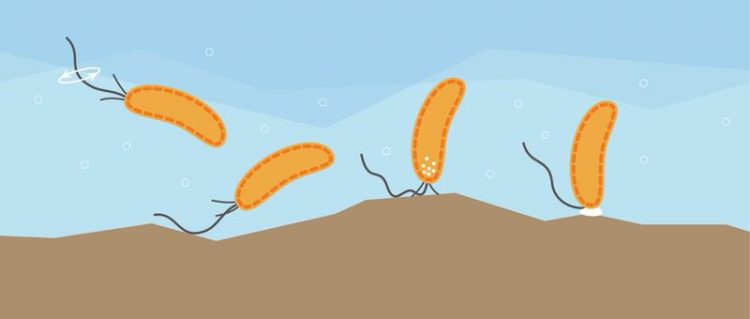Bacteria have a sense of touch

Sense of touch: Swimming bacteria can sense surfaces with the flagellum. University of Basel, Biozentrum
Be it through mucosa or the intestinal lining, different tissues and surfaces of our body are entry gates for bacterial pathogens. The first few seconds – the moment of touch – are often critical for successful infections.
Some pathogens use mechanical stimulation as a trigger to induce their virulence and to acquire the ability to damage host tissue. The research group led by Prof. Urs Jenal, at the Biozentrum of the University of Basel, has recently discovered how bacteria sense that they are on a surface and what exactly happens in these crucial first few seconds.
Research focused only on chemical signals
In recent decades, research has made enormous progress in exploring how bacteria perceive and process chemical signals. “However, we have little knowledge of how bacteria read out mechanical stimuli and how they change their behavior in response to these cues,” says Jenal.
“Using the non-pathogenic Caulobacter as a model, our group was able to show for the first time that bacteria have a ‘sense of touch’. This mechanism helps them to recognize surfaces and to induce the production of the cell's own instant adhesive.”
How bacteria recognize surfaces and adhere to them
Swimming Caulobacter bacteria have a rotating motor in their cell envelope with a long protrusion, the flagellum. The rotation of the flagellum enables the bacteria to move in liquids. Much to the surprise of the researchers, the rotor is also used as a mechano-sensing organ. Motor rotation is powered by proton flow into the cell via ion channels. When swimming cells touch surfaces, the motor is disturbed and the proton flux interrupted.
The researchers assume that this is the signal that sparks off the response: The bacterial cell now boosts the synthesis of a second messenger, which in turn stimulates the production of an adhesin that firmly anchors the bacteria on the surface within a few seconds. “This is an impressive example of how rapidly and specifically bacteria can change their behavior when they encounter surfaces,” says Jenal.
Better understanding of infectious diseases
“Even though Caulobacter is a harmless environmental bacterium, our findings are highly relevant for the understanding of infectious diseases. What we discovered in Caulobacter also applies to important human pathogens,” says Jenal. In order to better control and treat infections, it is mandatory to better understand processes that occur during these very first few seconds after surface contact.
Original article
Isabelle Hug, Siddharth Deshpande, Kathrin S. Sprecher, Thomas Pfohl, Urs Jenal
Second messenger-mediated tactile response by a bacterial rotary motor
Science (2017). doi: 10.1126/science.aan5353
https://doi.org/10.1126/science.aan5353
Further Information
Prof. Dr. Urs Jenal, University of Basel, Biozentrum, Tel. +41 61 207 21 35, email: urs.jenal@unibas.ch
Dr. Katrin Bühler, University of Basel, Biozentrum, Communications, Tel. +41 61 207 09 74, email: katrin.buehler@unibas.ch
https://unibas.ch/en/News-Events/News/Uni-Research/Bacteria-have-a-sense-of-touc…
Media Contact
All latest news from the category: Life Sciences and Chemistry
Articles and reports from the Life Sciences and chemistry area deal with applied and basic research into modern biology, chemistry and human medicine.
Valuable information can be found on a range of life sciences fields including bacteriology, biochemistry, bionics, bioinformatics, biophysics, biotechnology, genetics, geobotany, human biology, marine biology, microbiology, molecular biology, cellular biology, zoology, bioinorganic chemistry, microchemistry and environmental chemistry.
Newest articles

A ‘language’ for ML models to predict nanopore properties
A large number of 2D materials like graphene can have nanopores – small holes formed by missing atoms through which foreign substances can pass. The properties of these nanopores dictate many…

Clinically validated, wearable ultrasound patch
… for continuous blood pressure monitoring. A team of researchers at the University of California San Diego has developed a new and improved wearable ultrasound patch for continuous and noninvasive…

A new puzzle piece for string theory research
Dr. Ksenia Fedosova from the Cluster of Excellence Mathematics Münster, along with an international research team, has proven a conjecture in string theory that physicists had proposed regarding certain equations….



